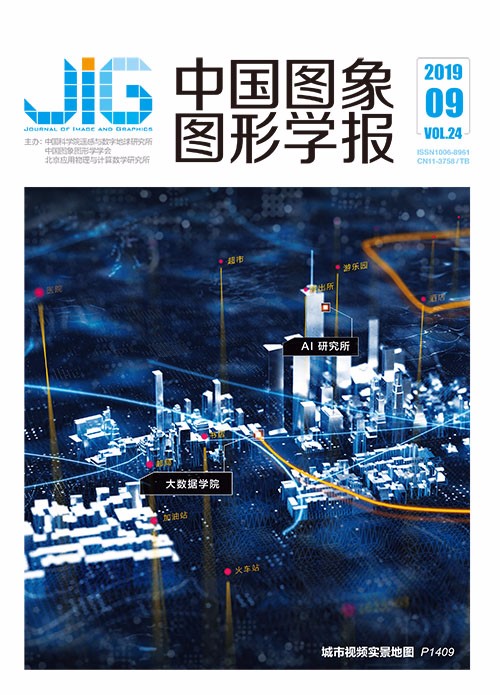
双重字典学习与自适应PCNN相结合的医学图像融合
摘 要
目的 针对基于稀疏编码的医学图像融合方法存在的细节保存能力不足的问题,提出了一种基于卷积稀疏表示双重字典学习与自适应脉冲耦合神经网络(PCNN)的多模态医学图像融合方法。方法 首先通过已配准的训练图像去学习卷积稀疏与卷积低秩子字典,在两个字典下使用交替方向乘子法(ADMM)求得其卷积稀疏表示系数与卷积低秩表示系数,通过与对应的字典重构得到卷积稀疏与卷积低秩分量;然后利用改进的的拉普拉斯能量和(NSML)以及空间频率和(NMSF)去激励PCNN分别对卷积稀疏与卷积低秩分量进行融合;最后将融合后的卷积稀疏与卷积低秩分量进行组合得到最终的融合图像。结果 对灰度图像与彩色图像进行实验仿真并与其他融合方法进行比较,实验结果表明,所提出的融合方法在客观评估和视觉质量方面明显优于对比的6种方法,在4种指标上都有最优的表现;与6种多模态图像融合方法相比,3组实验平均标准差分别提高了7%、10%、5.2%;平均互信息分别提高了33.4%、10.9%、11.3%;平均空间频率分别提高了8.2%、9.6%、5.6%;平均边缘评价因子分别提高了16.9%、20.7%、21.6%。结论 与其他稀疏表示方法相比,有效提高了多模态医学图像融合的质量,更好地保留了源图像的细节信息,使融合图像的信息更加丰富,符合人眼的视觉特性,有效地辅助医生进行疾病诊断。
关键词
Medical image fusion using double dictionary learning and adaptive PCNN
Wang Lifang, Dou Jieliang, Qin Pinle, Lin Suzhen, Gao Yuan, Zhang Chengcheng(College of Big Data, North University, Shanxi Provincial Key Laboratory of Biomedical Imaging and Imaging Big Data, Taiyuan 030051, China) Abstract
Objective The fusion of multimodal medical images is an important medical imaging method that integrates complementary information from multimodal images to produce new composite images. Sparse representation has achieved great success in medical image fusion in the past few years. However, given that the sparse representation method is based on sliding window technology, the ability to preserve the details of the fused image is insufficient. Therefore, a multimodal medical image fusion method based on convolution sparse representation double dictionary learning and adaptive PCNN(pulse couple neural network) is proposed. Method According to the low-rank and sparsity characteristics of the image, the method decomposes the source image into two parts and constructs a double dictionary based on convolution sparse representation. The sparse component contains a large amount of detail textures, and the low-rank component contains basic information such as contour brightness. First, the low-rank feature and sparse feature are extracted from the training image to form two basic dictionaries to represent the test image. The dictionary learning model is improved by adding low-rank and sparse constraints to the low-rank component and the sparse component, respectively, to enhance the discriminability of the double dictionary. In the process of dictionary learning, the method of alternating iterative updating is divided into three parts:auxiliary variable update, sparse coding, and dictionary updates. A convolutional sparse and convoluted low-rank sub-dictionary for the training image is obtained by a three-part cyclic update. Then, the total variation regularization is incorporated into the image decomposition model, and the Fourier domain-based alternating direction multiplier method is used to obtain the representation coefficients of the source image sparse component and the low-rank component in the respective sub-dictionaries. The process is alternately divided into two parts iteratively, namely, convolution sparse coefficient update and convolution low-rank coefficient update. Second, the sparse component of the source image is obtained by convolving the convolutional sparse coefficient with the corresponding sub-dictionary. Similarly, the convolution low-rank coefficient is convolved with the corresponding sub-dictionary to obtain the low-rank component of the source image. The novel sum-modified spatial frequency of the sparse component is calculated as the external excitation of the pulse-coupled neural network to preserve the details of the image, and the link strength is adaptively determined by the regional average gradient to obtain a firing map of the sparse component. The novel sum-modified Laplacian of the low-rank component is calculated as the external excitation of the pulse coupled neural network, and the link strength is adaptively determined by the regional average gradient to obtain the firing map. The fused sparse components are obtained by comparing the number of firings of different sparse components. Similarly, the low-rank components of different source images are fused through the firing map. Finally, the fused image is obtained by combining convolution sparse and convolution low-rank components, thereby further improving the quality of the fused image. Result Three sets of brain multimodal medical images (namely, CT/MR, MR/PET, and MR/SPECT) were simulated and compared with those processed by other fusion methods. Experimental results show that the proposed fusion method is significantly superior to the six methods according to objective evaluation and visual quality comparison and has the best performance in four indicators. Compared with the six multi-mode image fusion methods, the mean standard deviation of the three groups of experiments increased by 7%, 10%, and 5.2%, respectively. The average mutual information increased by 33.4%, 10.9%, and 11.3%, respectively. The average spatial frequency increased by 8.2%, 9.6%, and 5.6%, respectively. The average marginal evaluation factors increased by 16.9%, 20.7%, and 21.6%, respectively. Conclusion Compared with other sparse representation methods, the proposed algorithm effectively improves the quality of multimodal medical image fusion, better preserves the detailed information of the source image, enriches the information of the fused image, and conforms to the visual characteristics of the human eye, thereby effectively assisting doctors in diagnosing diseases.
Keywords
medical image fusion double dictionary learning convolution sparse convolution low rank pulse coupled neural network(PCNN)
|



 中国图象图形学报 │ 京ICP备05080539号-4 │ 本系统由
中国图象图形学报 │ 京ICP备05080539号-4 │ 本系统由